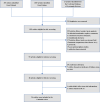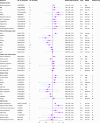Risk factors for nephrolithiasis formation: an umbrella review
- PMID: 38814276
- PMCID: PMC11392093
- DOI: 10.1097/JS9.0000000000001719
Risk factors for nephrolithiasis formation: an umbrella review
Abstract
Objective: Nephrolithiasis is prevalent and burdensome worldwide. At present, evidence on the risk factors for nephrolithiasis is unconsolidated and the associations remain uncertain. The authors systematically evaluate the robustness of the meta-analytic evidence and aid more reliable interpretations of the epidemiological relationships.
Methods: The authors conducted a comprehensive review of the meta-analyses, screened the included studies with the aid of the AMSTAR 2 evaluation tool, and then used R (4.1.1) software to perform data analysis to evaluate the association between candidate risk factors and kidney stones, and evaluated the credibility of the evidence of the association between risk factors and kidney stones according to the GRADE classification, and finally obtained the strength and effectiveness of the association.
Results: The authors finally included 17 meta-analyses regarding 46 risk factors, 34 of which (73.9%) showed statistically significant association with nephrolithiasis. Among the significant associations, the authors found that waist circumference, BMI, dietary intake and fructose intake were positively correlated with the occurrence and development of nephrolithiasis. Caffeine, dietary fiber and DASH-diet showed a tendency to reduce kidney stones. Interestingly, calcium supplementation, dietary calcium, and vitamin D, which are widely believed to be responsible for stone formation, made no difference or even reduced the risk of nephrolithiasis.
Conclusions: The authors' study demonstrates the suggestive causal (central obesity, type 2 diabetes, gout, dietary sodium, fructose intake and higher temperatures) risk factors of nephrolithiasis. The authors also demonstrate the suggestive causal (coffee/alcohol/beer intake, dietary calcium and DASH-diet) protective factors of nephrolithiasis. To provide epidemiological basis for the treatment and prevention of nephrolithiasis.
Copyright © 2024 The Author(s). Published by Wolters Kluwer Health, Inc.
Conflict of interest statement
None.
Figures



Similar articles
-
Dietary and lifestyle factors for primary prevention of nephrolithiasis: a systematic review and meta-analysis.BMC Nephrol. 2020 Jul 11;21(1):267. doi: 10.1186/s12882-020-01925-3. BMC Nephrol. 2020. PMID: 32652950 Free PMC article.
-
Dietary treatment of urinary risk factors for renal stone formation. A review of CLU Working Group.Arch Ital Urol Androl. 2015 Jul 7;87(2):105-20. doi: 10.4081/aiua.2015.2.105. Arch Ital Urol Androl. 2015. PMID: 26150027 Review.
-
Salt and nephrolithiasis.Nephrol Dial Transplant. 2016 Jan;31(1):39-45. doi: 10.1093/ndt/gfu243. Epub 2014 Jul 16. Nephrol Dial Transplant. 2016. PMID: 25031016 Review.
-
Dietary intake of fiber, fruit and vegetables decreases the risk of incident kidney stones in women: a Women's Health Initiative report.J Urol. 2014 Dec;192(6):1694-9. doi: 10.1016/j.juro.2014.05.086. Epub 2014 May 22. J Urol. 2014. PMID: 24859445 Free PMC article.
-
Influence of BMI in nephrolithiasis in an Appalachian pediatric population: A single-center experience.J Pediatr Urol. 2018 Aug;14(4):330.e1-330.e8. doi: 10.1016/j.jpurol.2018.03.024. Epub 2018 Jun 7. J Pediatr Urol. 2018. PMID: 29887297
Cited by
-
Balancing Stone Prevention and Kidney Function: A Therapeutic Dilemma.J Clin Med. 2025 May 23;14(11):3678. doi: 10.3390/jcm14113678. J Clin Med. 2025. PMID: 40507440 Free PMC article. Review.
-
Age-stratified analysis of the BMI-kidney stone relationship: findings from a national cross-sectional study.Front Med (Lausanne). 2025 Feb 12;12:1513799. doi: 10.3389/fmed.2025.1513799. eCollection 2025. Front Med (Lausanne). 2025. PMID: 40018353 Free PMC article.
-
Self-Reported Symptoms of Obstructive Sleep Apnea are Associated with Increased Risk of Kidney Stones: A Cross-Sectional Study from NHANES 2015-2020.Nat Sci Sleep. 2024 Dec 18;16:2099-2110. doi: 10.2147/NSS.S491657. eCollection 2024. Nat Sci Sleep. 2024. PMID: 39712882 Free PMC article.
-
A real-world pharmacovigilance study of efgartigimod alfa in the FDA adverse event reporting system database.Front Pharmacol. 2025 Apr 16;16:1510992. doi: 10.3389/fphar.2025.1510992. eCollection 2025. Front Pharmacol. 2025. PMID: 40308753 Free PMC article.
-
A cross-sectional and bioinformatics-based analysis: perirenal fat thickness as a superior predictor of kidney stone disease.Lipids Health Dis. 2025 Aug 29;24(1):269. doi: 10.1186/s12944-025-02686-4. Lipids Health Dis. 2025. PMID: 40877937 Free PMC article.
References
-
- Sorokin I, Mamoulakis C, Miyazawa K, et al. . Epidemiology of stone disease across the world. World J Urol 2017;35:1301–1320. - PubMed
-
- Zeng G, Mai Z, Xia S, et al. . Prevalence of kidney stones in China: an ultrasonography based cross-sectional study. BJU Int 2017;120:109–116. - PubMed
-
- Strazzullo P, Barba G, Vuotto P, et al. . Past history of nephrolithiasis and incidence of hypertension in men: a reappraisal based on the results of the Olivetti Prospective Heart Study. Nephrol Dial Transplant 2001;16:2232–2235. - PubMed
Publication types
MeSH terms
LinkOut - more resources
Full Text Sources
Medical

